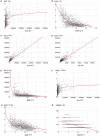Green Space Cooling Effect and Contribution to Mitigate Heat Island Effect of Surrounding Communities in Beijing Metropolitan Area
- PMID: 35586004
- PMCID: PMC9108199
- DOI: 10.3389/fpubh.2022.870403
Green Space Cooling Effect and Contribution to Mitigate Heat Island Effect of Surrounding Communities in Beijing Metropolitan Area
Abstract
With the rapid process of urbanization and global warming, many metropolises are vulnerable to high temperatures in summer, threatening the health of residents. However, green spaces can generate a cooling effect to mitigate the urban heat island effect in big cities. They can also help to improve the living quality and wellbeing of surrounding residents. In this paper, we utilized the radiative transfer equation algorithm, k-means clustering algorithm, big data crawling, and spatial analysis to quantify and map the spatial distribution, cooling capacity, and cooling contribution for surrounding communities of 1,157 green spaces within Beijing Fifth Ring Road, a typical metropolitan area. The findings showed that (1) the area proportion of the heat island in the study area is larger than that of the cooling island. Accounting for only about 30% area in the study area, the green spaces reduce the average land surface temperature by 1.32°C. (2) The spatial features of green space, such as area and shape complexity, have a significant influence on its cooling effect. (3) Four clusters of green spaces with specific spatial features and cooling capacity were identified. And there were differences among these clusters in green space cooling contribution for the surrounding communities. (4) The differences in green space cooling contribution also existed in different urban zones. Specifically, the middle zone performed significantly better than the inner and outer zones. (5) We furthered in finding that some green spaces with medium and high cooling contributions need to improve their cooling capacity soon, and some green spaces with low cooling contributions or no contributions have a good potential for constructing new communities in the future. Our study could help planners and government understand the current cooling condition of green spaces, to improve their cooling capacity, mitigate the urban heat island effect, and create a comfortable and healthy thermal environment in summer.
Keywords: cooling contribution; cooling effect; green space; metropolitan area; resident health; urban thermal environment.
Copyright © 2022 Liu, Zhao, Sun, Xu, Huang and Zhu.
Conflict of interest statement
The authors declare that the research was conducted in the absence of any commercial or financial relationships that could be construed as a potential conflict of interest.
Figures










Similar articles
-
Interaction of Urban Rivers and Green Space Morphology to Mitigate the Urban Heat Island Effect: Case-Based Comparative Analysis.Int J Environ Res Public Health. 2021 Oct 29;18(21):11404. doi: 10.3390/ijerph182111404. Int J Environ Res Public Health. 2021. PMID: 34769917 Free PMC article.
-
How can urban green spaces be planned to mitigate urban heat island effect under different climatic backgrounds? A threshold-based perspective.Sci Total Environ. 2023 Sep 10;890:164422. doi: 10.1016/j.scitotenv.2023.164422. Epub 2023 May 24. Sci Total Environ. 2023. PMID: 37236468
-
Cooling Effect of Green Space and Water on Urban Heat Island and the Perception of Residents: A Case Study of Xi'an City.Int J Environ Res Public Health. 2022 Nov 12;19(22):14880. doi: 10.3390/ijerph192214880. Int J Environ Res Public Health. 2022. PMID: 36429599 Free PMC article.
-
[A review on the urban green space cooling effect based on field measurement of air temperature].Ying Yong Sheng Tai Xue Bao. 2017 Apr 18;28(4):1387-1396. doi: 10.13287/j.1001-9332.201704.012. Ying Yong Sheng Tai Xue Bao. 2017. PMID: 29741338 Review. Chinese.
-
Urban green space cooling effect in cities.Heliyon. 2019 Apr 8;5(4):e01339. doi: 10.1016/j.heliyon.2019.e01339. eCollection 2019 Apr. Heliyon. 2019. PMID: 31008380 Free PMC article. Review.
Cited by
-
Contribution of local climate zones to the thermal environment and energy demand.Front Public Health. 2022 Aug 9;10:992050. doi: 10.3389/fpubh.2022.992050. eCollection 2022. Front Public Health. 2022. PMID: 36016886 Free PMC article.
-
Global climate change: The dangers of heatwaves for chronic obstructive pulmonary disease patients cannot be ignored.J Glob Health. 2024 Sep 6;14:03032. doi: 10.7189/jogh.14.03032. J Glob Health. 2024. PMID: 39238356 Free PMC article. No abstract available.
-
Compound Risk of Air Pollution and Heat Days and the Influence of Wildfire by SES across California, 2018-2020: Implications for Environmental Justice in the Context of Climate Change.Climate (Basel). 2022 Oct;10(10):145. doi: 10.3390/cli10100145. Epub 2022 Oct 1. Climate (Basel). 2022. PMID: 38456148 Free PMC article.
-
The impact of urban parks on the thermal environment of built-up areas and an optimization method.PLoS One. 2025 Mar 6;20(3):e0318633. doi: 10.1371/journal.pone.0318633. eCollection 2025. PLoS One. 2025. PMID: 40048485 Free PMC article.
References
-
- Rauf S, Pasra MM, Yuliani. Analysis of correlation between urban heat islands (UHI) with land-use using sentinel 2 time-series image in Makassar city. IOP Conf Ser Earth Environ Sci. (2020) 419:12088. 10.1088/1755-1315/419/1/012088 - DOI
-
- Zhao J, Yan Y, Deng H, Liu G, Shao G. Remarks about landsenses ecology and ecosystem services. Int J Sust Dev World Ecol. (2020) 27:1–6. 10.1080/13504509.2020.1718795 - DOI
-
- Zhao ZQ, He BJ, Li LG, Wang HB, Darko A. Profile and concentric zonal analysis of relationships between land use/land cover and land surface temperature: case study of Shenyang, China. Energy Build. (2017) 155:282–95. 10.1016/j.enbuild.2017.09.046 - DOI
-
- Wang J, Chen Y, Liao W, He G, Tett SFB, Yan Z, et al. . Anthropogenic emissions and urbanization increase risk of compound hot extremes in cities. Nat Clim Change. (2021) 11:1084–9. 10.1038/s41558-021-01196-2 - DOI
Publication types
MeSH terms
LinkOut - more resources
Full Text Sources

